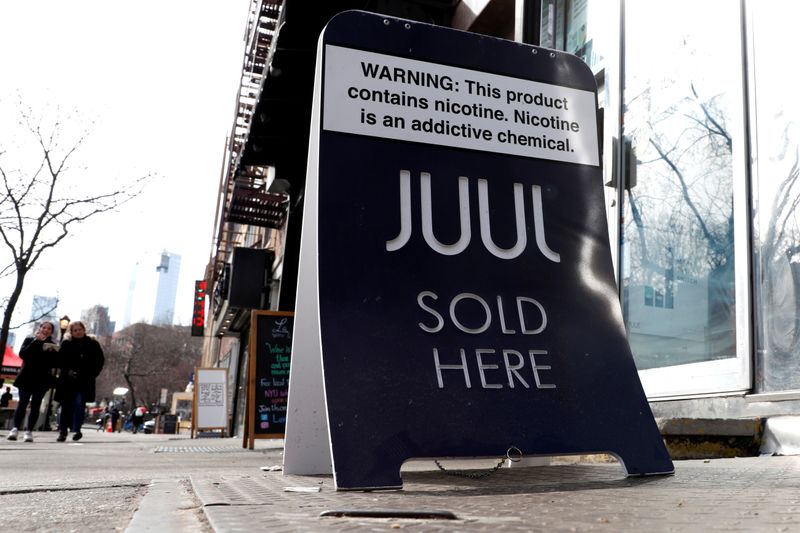This post was originally published on this site
https://i-invdn-com.akamaized.net/trkd-images/LYNXMPEFBG1K2_L.jpg
By Chris Kirkham
(Reuters) – The nicotine formula used by controversial e-cigarette maker Juul Labs Inc is nearly identical to the flavor and addictive profile of Altria Group (NYSE:) Inc’s highly successful Marlboro cigarette brand, new research suggests.
A study released on Tuesday from researchers at Portland State University in Oregon helps to explain why a growing number of young people who never smoked cigarettes have become regular users of Juul vaping devices.
The formulation of Juul’s nicotine aerosol was designed to make it far easier for users to inhale larger quantities of nicotine without gagging, gasping or coughing – or even noticing.
“It becomes obvious why novice users, people who’ve never smoked before, find it easy to try Juul,” said David Peyton, a professor of chemistry at Portland State University who worked on the study, published in the journal Tobacco Control. “And once you try it, you’re getting dosed with a high concentration of nicotine.”
Directly comparing Juul vaping devices to Marlboro cigarettes, the researchers analyzed the amount and chemical makeup of the nicotine in Juul’s cartridge-like disposable “pods.”
In addition to sweet flavors and its sleek, flash drive-like design, Juul is notable for popularizing what are known as “nicotine salts,” a smoother form of nicotine than what was contained in earlier e-cigarettes, according to Juul’s own patents and outside research on their formula.
By adding organic acids to liquid nicotine, San Francisco-based Juul was able to reduce the amount of “freebase nicotine” in the aerosol that users inhale.
Freebase nicotine, common in e-cigarette liquid prior to Juul’s arrival in 2015, is harsh and difficult to inhale at high concentrations. Juul virtually eliminated the harsh side effects.
‘ALL THE THINGS ABOUT MARLBORO THAT ARE ADDICTIVE’
While e-cigarettes have been marketed as a means to help smokers quit or cut down, public health officials have expressed concern that they are drawing a new, younger generation into nicotine addiction. Juul has come under intense scrutiny from regulators, lawmakers and attorneys general over the surging popularity of its products among teenagers in recent years.
A recent study found that nearly 60% of high schoolers and 54% of middle schoolers who use nicotine vaping products said Juul was their usual brand.
Peyton and fellow researchers James Pankow and Anna Duell measured the amounts of nicotine in Juul and how much of that nicotine was in the harsher freebase form of the chemical.
They determined that Juul’s potency and flavor profile was almost exactly the same as Marlboro cigarettes, describing Juul as an “e-cigarette analog” of the U.S. market-leading brand.
“Juul is all the things about Marlboro that are addictive,” said Pankow, an expert in the chemistry of nicotine and tobacco smoke. “Then they take away the bad smell and add some flavors. It’s a much more pleasant experience.”
Under pressure from regulators and lawmakers, Juul in recent months stopped selling flavors other than menthol and tobacco in the United States, but continues to sell fruit and dessert flavors in other countries.
A study released last month by researchers at Pennsylvania State University found that Juul delivered more nicotine to the bloodstream, and at a faster rate, than earlier e-cigarettes, and that its nicotine boost was similar to that of a cigarette.
Juul Labs did not immediately respond to a request for comment on the new study’s findings.
In an earlier statement, the company said its products were designed to get adult smokers to switch from cigarettes. Therefore the company “sought to create a nicotine-based e-liquid that mimicked the nicotine experience” in cigarettes, according to the statement.
“Providing a similar nicotine experience was a priority given the fact that early generation e-cigarettes had failed in this respect and, as a result, did not convert a significant number of adult smokers from cigarettes,” the company said.
Juul cited studies it commissioned showing that between 30% to 50% of adult smokers who use Juul “switch completely from smoking cigarettes within six months.”
A separate U.S. study released on Monday found that e-cigarette use significantly increases the risk of developing chronic lung conditions such as asthma or emphysema.
The Portland State researchers noted that Juul had rapidly duplicated – and improved – a formula that tobacco growers and purveyors took centuries to perfect: A way to deliver potent amounts of nicotine through inhalation.
The tobacco industry for centuries tinkered with the chemistry of nicotine in tobacco through various drying techniques and additives, aiming to make burned tobacco smoother to inhale, the researchers noted.
They said Juul’s evolution from earlier e-cigarettes was reminiscent of the tobacco industry’s cigarette development.
Juul has “essentially duplicated the world’s most popular cigarettes, which means this should be attractive to cigarette users,” Peyton said. “This is probably also a good way to get the curious novice who has never smoked.
“It’s difficult to go for the one population without hitting the second.”

